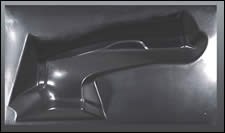Custom Moldmaking Process Technology Slashes Processing Time and Costs
A breakthrough molding technology has been developed that delivers considerable time reductions and cost savings for fabricators of parts constructed from composite materials.
A breakthrough molding technology has been developed that delivers considerable time reductions and cost savings for fabricators of parts constructed from composite materials.
Custom Moldmaking Process Technology (CMPT)®, devel-oped by General Magnaplate Corp. (Linden, NJ)—a specialty coatings manufacturer—reduces the total time needed to make large, all-metal lay-up molds for complex reinforced composites from the current six- to 12-month period to as little as six weeks. It also slashes tooling capital investment by one-third, notes Edmund Aversenti, General Magnaplate’s Chief Operating Officer. “Tools manufactured with this process reproduce fine pattern detail—with dimensional stability—and the process is consistent with traditional EDM finished tooling,” Aversenti states. “It represents a quantum leap in the composite fabrication industry—making it possible to drastically lower the final cost for many molded, complex-shaped parts, especially those with contours. Such contoured composite parts are used in applications as diverse as Stealth bombers and refrigerator doors.”
How It Works
The process itself is a dense, multi-directional, all-metal-weaving process, which eliminates the need to machine layup-molds out of large, heavy metal ingots or castings that require so much time to fabricate. “The tool is made by robotically weaving any metal alloy over a master model of a contoured tool,” Aversenti explains. “The application speed and pattern is computer programmed and robotically controlled to assure reproducibility. Similar to the lay-up of a composite part, the weaving of the metal over the master model is done in a warp-and-fill manner.”
A CMPT tool face typically ranges in thickness from 0.38-inch minimum to 4 inches maximum, Aversenti notes. “At 0.5 inch thickness, a CMPT tool withstood pressures of 1,500 psi. An all-metal CMPT tool can support cure cycles that range from ambient to 750°F—depending on the alloy used—to accommodate the composite material’s cure cycle.
“Parts can be cured on a CMPT tool with or without vacuum,” he continues. “The unsealed version allows volatiles generated during the cure process to be pulled down through the tool itself.” Additionally, a tool can be made of almost any alloy or hybrid alloy in as little as six weeks from a CAD drawing to master Model to programming of the robots to an all-metal tool ready for production. In some instances, the tool can be made from the prototype or plastic part itself.
Significant Savings
Aversenti states the all-metal custom tool, with contours, demonstrates a savings of around 60 percent or more—depending on the tool configuration, metal alloy and the reduction in turnaround time (six weeks versus six months). He adds the tool exhibits durability up to 10 times that of soft tooling systems. “It combines the accuracy, precision, and good surface quality previously available only after machining; enables high-temperature tooling for long or short production runs for cures up to 750° F; and the tool face can be made from any alloy—from aluminum to zinc—including high nickel INVAR.
“The shorter leadtimes and lower costs of CMPT will permit more frequent model changes by larger companies as they quickly adjust designs to consumer tastes,” Aversenti continues. “A customized tool leasing program being developed allows smaller companies to board the ‘composite express’ by manufacturing and selling complex shapes without making major capital investments and without long leadtimes between concepts and salable products.”
Related Content
How to Use Thermal Management to Improve Mold Cooling
A review of common mold cooling issues and possible solutions, including 3D printing applications.
Read MoreIn "Hybrid" FIM Process, 3D Printing Complements Injection Molding
Alpine Advanced Materials used a desktop 3D printer and the freeform injection molding process to reduce prototype tooling production time and cost for its customers.
Read More3D Printing Enables Better Coolant Delivery in Milling Operations
Just like 3D printing enabled conformal cooling channels in molds, additive manufacturing is now being used to optimize coolant delivery in cutting tools.
Read MoreMold Materials, 3D Printing Technologies for Next-Gen Moldmaking
As moldmaking advances, so too do the materials and processes involved in their efficient production, including these latest mold materials and 3D printing technologies.
Read MoreRead Next
Are You a Moldmaker Considering 3D Printing? Consider the 3D Printing Workshop at NPE2024
Presentations will cover 3D printing for mold tooling, material innovation, product development, bridge production and full-scale, high-volume additive manufacturing.
Read MoreReasons to Use Fiber Lasers for Mold Cleaning
Fiber lasers offer a simplicity, speed, control and portability, minimizing mold cleaning risks.
Read More













.jpg;maxWidth=300;quality=90)









